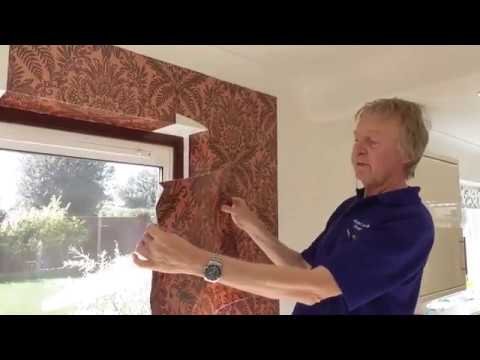Wallpapering around a window can feel daunting, but it’s easier than you might think. Start by measuring the window area and ensuring your wallpaper aligns perfectly with the natural light and aesthetics of your room.
Cut the wallpaper to fit snugly around the frame, ensuring you have enough excess to trim later.
Finally, smooth out the wallpaper as you apply it, watching for bubbles or unevenness. With a little patience and attention to detail, you’ll achieve a polished finish that enhances your space beautifully.
How to Wallpaper Around a Window
Wallpapering around a window can be both a fun and rewarding project. Whether you’re redecorating a room or trying to give your space a fresh look, knowing how to wallpaper correctly around windows is essential. This guide will walk you through everything you need to know about wallpapering around a window, from preparation to the final touches.
Understanding Wallpapering Basics
Before diving into the specifics of wallpapering around windows, let’s cover some basic wallpapering knowledge. This foundation will help you make informed decisions as you work on your project.
Types of Wallpaper
There are various types of wallpaper available, each with its unique qualities. Familiarizing yourself with these different types can help you choose the right one for your project:
- Pasted Wallpaper: This type requires adhesive to be applied to the wall or back of the wallpaper sheets.
- Pre-pasted Wallpaper: This wallpaper has adhesive already applied; you just need to wet it before sticking.
- Vinyl Wallpaper: Durable and easy to clean, making it ideal for high-traffic areas.
- Textured Wallpaper: Offers depth and dimension, adding visual interest to a room.
Tools and Materials
To successfully wallpaper around a window, you’ll need some essential tools and materials. Gather the following items to ensure a smooth process:
- Wallpaper rolls
- Wallpaper paste (if applicable)
- Measuring tape
- Utility knife
- Wallpaper brush or smoothing tool
- Level
- Straightedge (for cutting)
- Scissors
- Pencil
- Drop cloths (to protect your floors)
Preparing the Area
Proper preparation is crucial for a successful wallpapering job. Here are the steps to take before applying wallpaper around your window.
Clear the Workspace
Start by clearing the area around the window. Remove any furniture, curtains, or blinds. This space will help you maneuver easily while working.
Inspect and Clean the Surface
Make sure the wall around the window is clean and smooth. Here’s what to check for:
- Look for holes or cracks. Fill any imperfections with spackle, and sand it down once dry.
- Dust and clean the wall. Use a damp cloth to remove any dirt and grime. Let it dry completely before proceeding.
Measure and Cut the Wallpaper
Accurate measurements are fundamental for a seamless look. Here’s how to get it right:
1. **Measure the Wall**: Use your measuring tape to find the width and height of the wall surrounding the window.
2. **Cut the Wallpaper**: Based on your measurements, cut the wallpaper. Always cut extra length to ensure you have enough to trim later.
Applying Wallpaper Around the Window
Now comes the exciting part—applying the wallpaper! Follow these steps closely to achieve the best results.
Start with the Main Panels
When wallpapering around a window, it helps to start with the main wall sections first before working around the window itself.
1. **Apply Paste**: If you’re using non-pre-pasted wallpaper, apply the paste evenly on the back. For pre-pasted wallpaper, soak it as directed.
2. **Align the First Panel**: Position the first panel of wallpaper on the wall, ensuring it is straight. Use your level to guide you.
3. **Smooth It Out**: With a smoothing tool or wallpaper brush, gently press down starting from the center and working your way outwards. This process removes air bubbles.
Wallpapering Around the Window Frame
This step is where precision is essential. Here’s a detailed way to handle wallpapering around the window:
1. **Cut Around the Window**: When you reach the window, use your utility knife to trim the wallpaper around the window frame. Be careful and cut slowly to avoid mistakes. If your window has a trim, carefully cut the wallpaper to go around it gracefully.
2. **Fitting in Corners**: For corners and edges, make sure to fold the wallpaper neatly to avoid tearing.
3. **Use a Straightedge**: For clean cuts, use a straightedge when trimming the excess material. This approach prevents jagged edges.
Dealing with Difficult Areas
Sometimes, applying wallpaper around a window can present unique challenges. Here are a few tips for those tricky spots:
- Irregular Shapes: If your window has an unusual shape, you can create a template with paper to ensure you cut the wallpaper accurately.
- Outlets and Switches: For outlets, cut a small “X” in the wallpaper over the outlet and carefully trim it to fit. Always turn off the electricity before doing this!
Finishing Touches
Once the wallpaper is smoothly applied, it’s time for the finishing touches.
Trimming Excess Wallpaper
After the wallpaper is up, you might notice some excess material around the window. Here’s how to trim it:
– Use your utility knife to carefully trim along the edges of the window frame.
– Make sure to hold the knife at a slight angle to avoid cutting too deeply into the wall.
Sealing the Edges
To ensure a lasting appearance, sealing the edges of your wallpaper is wise. This step helps prevent peeling and gives it a polished look:
1. **Apply Wallpaper Sealer**: Use a thin paintbrush to apply a clear wallpaper sealer along the edges of the wallpaper.
2. **Smooth the Edges**: Press the edges down gently with your smoothing tool after applying the sealer.
Final Inspection
Once everything is complete, do a final walk-through:
– Check for any bubbles or loose edges.
– Smooth out any bubbles with your smoothing tool.
– Adjust any areas that need touch-ups for a perfect finish.
Tips for Success
To ensure your wallpapering project around the window goes smoothly, keep these tips in mind:
- Work in Sections: Don’t rush. Take your time and work in manageable sections for more control.
- Stay Organized: Keep all tools and materials within reach to minimize distractions while working.
- Ask for Help: If you’re unsure about a section, don’t hesitate to ask someone for assistance.
Potential Issues and How to Solve Them
While wallpapering around a window can be straightforward, some issues may arise during the process. Here are common problems and solutions:
Air Bubbles
If you notice air bubbles forming after applying the wallpaper:
– Use a smoothing tool to gently push the bubbles toward the edges. If the bubble remains, slice it lightly with a utility knife and press out the air.
Misalignment
If you find that the wallpaper is not aligned properly, you can:
– Gently peel the wallpaper back and reapply it. Be cautious not to tear it, especially if using paste.
Peeling Edges
If the edges of the wallpaper start to peel away:
– Apply wallpaper sealer to the edges and press them down securely.
Wallpapering around a window may seem daunting, but with the right tools, materials, and techniques, you can achieve a stunning result. By taking the time to prepare, apply carefully, and finish with attention to detail, your new wallpaper can transform the space around your window. With a little patience and practice, you’ll become more comfortable tackling this DIY project on your own. Enjoy your beautifully wallpapered walls!
How To Wallpaper Around A Window | Wallpapering Tips | Homebase
Frequently Asked Questions
“`html
What tools do I need to wallpaper around a window?
To wallpaper around a window, gather the following tools: a measuring tape, a utility knife, a straight edge or ruler, a wallpaper brush or smoother, a sponge or cloth for cleaning, a paste brush, and a wallpaper seam roller. Having a step ladder may also help if the window is high up.
How do I measure the wallpaper needed for a window area?
To measure the wallpaper required for a window, start by measuring the height and width of the window frame. Multiply the height by the width to get the area of the window. Then, calculate the total wall area and subtract the window area from it. This will give you the amount of wallpaper needed for the wall, keeping in mind to allow for overlaps and pattern matching.
What is the best way to cut wallpaper around the window frame?
Cutting wallpaper around a window frame requires precision. Start by applying the wallpaper around the window, ensuring it overlaps the frame slightly. Use a straight edge to guide your utility knife when you trim the excess. Cut along the edge of the frame for clean lines, taking care not to cut into the wall underneath.
How do I avoid bubbles and wrinkles when wallpapering near a window?
To prevent bubbles and wrinkles, smoothly apply wallpaper starting from the center of the area and work your way outwards. Use a wallpaper brush or smoother to push out any air bubbles as you go. If you encounter a wrinkle, gently peel back the section and reapply it, smoothing it down again until it lays flat.
Should I wallpaper the window trim or leave it unpapered?
Whether to wallpaper the window trim depends on your desired aesthetic. Some prefer to wallpaper the trim for a seamless look, while others choose to leave it unpapered to create a contrast with the wall. Consider the overall design of the room and choose the option that best enhances your decor.
What should I do if the wallpaper doesn’t align perfectly around the window?
If the wallpaper doesn’t align perfectly around the window, assess the pattern and see if minor adjustments can be made. You can trim excess wallpaper or reposition it slightly to achieve a better match. If necessary, use a wallpaper seam roller to tuck in edges and blend the seams more seamlessly into the surrounding wallpaper.
“`
Final Thoughts
To successfully wallpaper around a window, begin by measuring and cutting the wallpaper accurately to fit the space. Apply adhesive to the back of the wallpaper sheets before carefully aligning them with the window’s edges.
As you work around the window, ensure the pattern matches seamlessly. Use a utility knife to trim any excess wallpaper for a clean finish.
By following these steps, you can achieve a polished look that enhances your room’s design. Remember these tips for how to wallpaper around a window, and enjoy your refreshed space.





